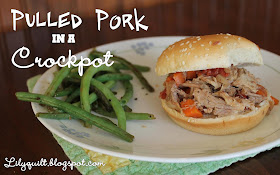I haven't been doing any quilting or sewing recently, but I've been wanting to start a new project and these blocks might actually get me excited enough to start. I want to make a lap quilt with these white-background blocks. I love how vintage and antique quilts use fabrics and combinations that I would never choose today. Look at the two below: green triangles and red floral? weird brown squares and pick floral?? It's hard to tell if Grandma had really different tastes than I do, or if she was just being thrifty and using up all the fabric she had on hand. Either way, these blocks have a completely different look than I would ever create.
 |
| I don't know what to call these blocks. Does anyone know the name of this pattern?? |
These are some of the squares I want to make into a baby blanket. Again, very different fabric choices than I usually make, but that adds to the charm and beauty of using vintage blocks!
The slowest part of starting these projects has been planning the quilting. I decided when I first saw the blocks that I want to learn to hand-quilt, to add to the vintage feel. That has taken some time, and I really, really need to keep practicing so that my quilting will do justice to Grandma's quilts!
-Lily
Linked up at some of the great blogs on my sidebar






























